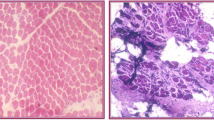Congenital muscular alpha-dystroglycanopaties (MDDGAs) are rare congenital muscular dystrophies that are accompanied by a variety of brain and eye malformations. More than 19 gene mutations have been identified in MDDGA, and 11 mutations have been identified in the Walker–Warburg syndrome, but these changes could only be confirmed in about 60–70% of the clinically diagnosed individuals. In recent studies, a novel recessive mutation has been described in the ISPD gene. This mutation abolishes the initial step in laminin-binding glycan synthesis by disrupting dystroglycan O-mannosylation. We present clinical and molecular data of a male newborn having severe hydrocephaly, hypotonia, microphthalmia, microcornea, bilateral cataract, and a high creatine kinase level; this case had a homozygous mutation in the ISPD gene in exon-3. We also provide a literature review with respect to patients with ISPD mutations and involvement of the CNS.
Similar content being viewed by others
References
X. N. Fu and H. Xiong, “Genetic and clinical advances of congenital muscular dystrophy,” Chin. Med. J. (Engl.), 130, No. 21, 2624–2631 (2017).
J. K. Mah, L. Korngut, K. M. Fiest, et al., “A systematic review and meta-analysis on the epidemiology of the muscular dystrophies,” Can. J. Neurol. Sci., 43, No. 1, 163–177 (2016).
T. Endo, “Glycobiology of α-dystroglycan and muscular dystrophy,” J. Biochem., 157, No. 1, 1–12 (2015).
M. Wiessner, A. Roos, C. J. Munn, et al., “Mutations in INPP5K, encoding a phosphoinositide 5-phosphatase, cause congenital muscular dystrophy with cataracts and mild cognitive impairment,” Am. J. Hum. Genet., 100, No. 3, 523–536 (2017).
T. Willer, H. Lee, M. Lommel, et al., “ISPD loss-offunction mutations disrupt dystroglycan O-mannosylation and cause Walker-Warburg syndrome,” Nat. Genet., 44, No. 5, 575–580 (2012).
J. Vajsar, C. Ackerley, D. Chitayat, and L. E. Becker, “Basal lamina abnormality in the skeletal muscle of Walker-Warburg syndrome,” Pediatr. Neurol., 22, No. 2, 139–143 (2000).
T. Roscioli, E. J. Kamsteeg, K. Buysse, et al., “Mutations in ISPD cause Walker-Warburg syndrome and defective glycosylation of α-dystroglycan,” Nat. Genet., 44, No. 5, 581–585 (2012).
S. Vuillaumier-Barrot, C. Bouchet-Séraphin, M. Chelbi, et al., “Identification of mutations in TMEM5 and ISPD as a cause of severe cobblestone lissencephaly,” Am. J. Hum. Genet., 91, No. 6, 1135–1143 (2012).
J. C. Czeschik, U. Hehr, B. Hartmann, et al., “160 kb deletion in ISPD unmasking a recessive mutation in a patient with Walker-Warburg syndrome,” Eur. J. Med. Genet., 56, No. 12, 689–694 (2013).
M. Trkova, V. Krutilkova, D. Smetanova, et al., “ISPD gene homozygous deletion identified by SNP array confirms prenatal manifestation of Walker-Warburg syndrome,” Eur. J. Med. Genet., 58, No. 8, 372–375 (2015).
S. Cirak, A. R. Foley, R. Herrmann, et al., “ISPD gene mutations are a common cause of congenital and limbgirdle muscular dystrophies,” Brain, 136, Pt. 1, 269–281 (2013).
Author information
Authors and Affiliations
Corresponding author
Additional information
Our journal usually does not accept “single-case stories”. In this paper, however, a case description is accompanied by detailed analysis of the own and literature data on clinical and molecular manifestations observed in the case and in a group of the respective congenital muscular dystrophies, and this information seems to be of obvious general interest. This is why we decided to publish, as an exception, this communication.
Rights and permissions
About this article
Cite this article
Gençpınar, P., Uyanık, G., Haspolat, Ş. et al. Clinical and Molecular Manifestations of Congenital Muscular Alpha-Dystroglycanopathy due to an ISPD Gene Mutation. Neurophysiology 51, 373–378 (2019). https://doi.org/10.1007/s11062-020-09831-y
Received:
Published:
Issue Date:
DOI: https://doi.org/10.1007/s11062-020-09831-y




